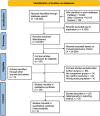The impact of livestock interventions on nutritional outcomes of children younger than 5 years old and women in Africa: a systematic review and meta-analysis
- PMID: 37485389
- PMCID: PMC10358768
- DOI: 10.3389/fnut.2023.1166495
The impact of livestock interventions on nutritional outcomes of children younger than 5 years old and women in Africa: a systematic review and meta-analysis
Abstract
Background: Nutrition-sensitive livestock interventions have the potential to improve the nutrition of communities that are dependent on livestock for their livelihoods by increasing the availability and access to animal-source foods. These interventions can also boost household income, improving purchasing power for other foods, as well as enhance determinants of health. However, there is a lack of synthesized empirical evidence of the impact and effect of livestock interventions on diets and human nutritional status in Africa.
Objective: To review evidence of the effectiveness of nutrition-sensitive livestock interventions in improving diets and nutritional status in children younger than 5 years old and in pregnant and lactating women.
Methods: Following PRISMA guidelines, we conducted a systematic review and meta-analysis of published studies reporting on the effect of livestock interventions on maternal and child nutrition in Africa. Data were extracted, synthesized, and summarized qualitatively. Key outcomes were presented in summary tables alongside a narrative summary. Estimation of pooled effects was undertaken for experimental studies with nutritional outcomes of consumption of animal-source foods (ASFs) and minimum dietary diversity (MDD). Fixed effects regression models and pooled effect sizes were computed and reported as odds ratios (ORs) together with their 95% confidence intervals (CI).
Results: After the screening, 29 research papers were included in the review, and of these, only 4 were included in the meta-analysis. We found that nutrition-sensitive livestock interventions have a significant positive impact on the consumption of ASFs for children < 5 years (OR = 5.39; 95% CI: 4.43-6.56) and on the likelihood of meeting minimum dietary diversity (OR = 1.89; 95% CI: 1.51-2.37). Additionally, the impact of livestock interventions on stunting, wasting, and being underweight varied depending on the type of intervention and duration of the program/intervention implementation. Therefore, because of this heterogeneity in reporting metrics, the pooled estimates could not be computed.
Conclusion: Nutrition-sensitive livestock interventions showed a positive effect in increasing the consumption of ASFs, leading to improved dietary diversity. However, the quality of the evidence is low, and therefore, more randomized controlled studies with consistent and similar reporting metrics are needed to increase the evidence base on how nutrition-sensitive livestock interventions affect child growth outcomes.
Keywords: Africa; children; livestock intervention; nutrition outcome; undernutrition; women.
Copyright © 2023 Muema, Mutono, Kisaka, Ogoti, Oyugi, Bukania, Daniel, Njuguna, Kimani, Makori, Omulo, Boyd, Osman, Gwenaelle, Jost and Thumbi.
Conflict of interest statement
The authors declare that the research was conducted in the absence of any commercial or financial relationships that could be construed as a potential conflict of interest.
Figures




References
-
- World Health Organization [WHO]. Nutrition in WHO African Region. Brazzavile: World Health Organization; (2017).
-
- UNICEF / WHO / World Bank Group. Levels and trends in child malnutrition UNICEF / WHO / World Bank Group Joint Child Malnutrition Estimates Key findings of the 2021 edition. Geneva: World Health Organization; (2021).
-
- United Nations Economic and Social Council. Report of the inter-agency and expert group on sustainable development goal indicators note. the oxford handbook on the United Nations. New York, NY: United Nations; (2016).
Publication types
LinkOut - more resources
Full Text Sources

